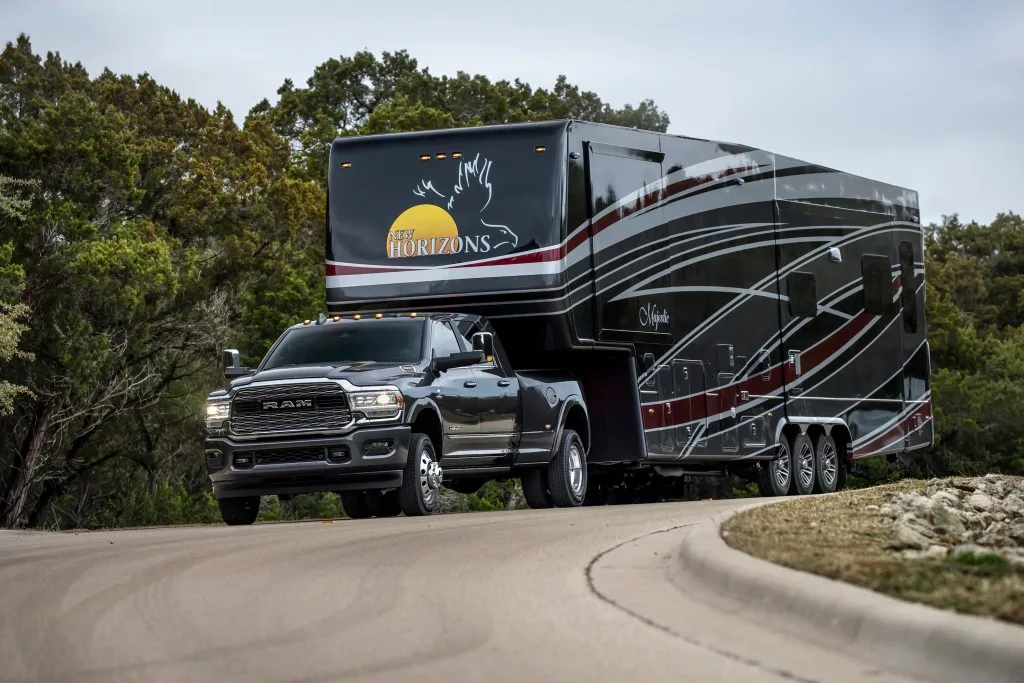Knowing the height of your RV is essential. This is especially true if you have any travel plans that involve the Northeast. A low clearance can do thousands of dollars of damage to an RV.
You don’t want to cross your fingers or say your prayers when approaching a bridge or overhang.
So what’s the maximum height for an RV on the interstate? Let’s measure up this RV rule.
What Is the Max Height for RVs?
The maximum height for an RV is 13’ 6”, which is a standardized height for vehicles across the country. However, don’t think that because your RV is shorter than 13’ 6”, you can drive on every road.
The height standard is typically for interstate travel, where semis and other large vehicles spend most of their time. It helps ensure these big rigs can freely travel the interstate system without worrying about overhead clearance issues.
Pro Tip: We use RV Trip Wizard to help us avoid roads with lower clearance.

How Is RV Height Measured?
You want to account for every inch when measuring your RV. You can’t just take the manufacturer’s word that your RV is a certain size. The height a manufacturer provides likely doesn’t include additional items like air conditioners, solar panels, or other upgrades.
If it’s towable: You need to hitch your RV to the tow vehicle to get the most accurate measurement. The height of your RV could be an inch or two different than when sitting on the ground. So hitch up your rig and grab your measuring tape and a ladder.
You’ll want to find the highest point of your RV. This will likely be an air conditioner, but it could include a vent or solar panels, depending on your rig. Measure the height of your RV to the ground and then add in the measurement of the air conditioner or other appliance.
Don’t forget the RV Cell Booster. These units can be higher than the AC cover.
The combined measurement will give you the most accurate measurement. When in doubt, round the number up an inch or two. This would ensure some wiggle room if you were inaccurate in your measuring.
Then, write down the height and put it on your dash or someplace you can easily see while driving. It can help if you have to remember the exact measurements. If you’ll travel to another country, convert it to metric.
Your RV manufacturer will state the height of official paperwork. However, always verify for yourself.
How Tall Are Most Interstate Bridges?
The U.S. Department of Transportation’s Federal Highway Administration recommends at least 14’ clearance for bridges going over interstates. This helps avoid any issues with semis and other rigs that must stay under 13’ 6”.
For most interstate roads, it’s not an issue, but New York and Connecticut often cut it extremely close for drivers nearing that 13’ 6” limit. Even if you know you’re under, your heart rate may increase as you approach some of the clearances in these states.
How High Are Unmarked Bridges?
Many bridges will have a bright yellow sign with black lettering letting you know the height of the bridge’s lowest point. However, if a bridge is taller than 16’ 6”, it typically won’t have a sign.
So if you approach a bridge on the interstate at a high rate of speed and don’t see a sign, you can most likely relax knowing you should have plenty of room between your vehicle’s roof and the bottom of the bridge.
Again, we never like to leave it to chance. That’s why RV Trip Wizard is so valuable to us.
Are Bridge Heights Exact?
The bridge height signs typically aren’t exact. However, they almost always have a small margin of grace built into them. The actual height of some bridges may be slightly taller than the signage indicates.
However, there’s typically no consistency regarding how much margin the highway department builds into the indicated height. When in doubt, don’t chance it. Damaging your RV and the bridge isn’t worth it.

What Happens if an RV Is Too Tall for a Bridge?
Some drivers have been lucky enough to avoid going under a low clearance by going around it or finding an alternative route. However, if the creators of 11foot8.com can teach us anything, not all drivers are lucky.
If an RV is too tall for a bridge, it will severely damage its roof and any accessories mounted to it. You’ll have to say goodbye to your air conditioner or solar panels, as the bridge will likely destroy them.
Depending on the severity of the accident, you may have to say goodbye to your rig for the foreseeable future. It could also completely total it. So make sure you stay alert and watch for low clearances.
What Do You Do if You Hit a Bridge?
If you do hit a bridge, you’ll want to make a couple of phone calls. First, call the local police department, then contact your insurance company. It’s a good idea to make these two phone calls from the scene to avoid any issues.
Law enforcement can file the necessary reports and collect any information they might need. Your insurance company can help open a claim and get the process going to fix your RV.
How Do You Avoid Low Clearance Bridges?
The best way to avoid low clearance bridges is to use a GPS unit specifically designed for RVs. These devices allow you to input your RV’s dimensions, and they will take you on RV-safe routes.
Also, remember that low clearances are everywhere when towing your RV. It’s not just bridges that can cause you trouble.
THIS RVER TOOK HIS RIG TO A DAIRY QUEEN DRIVE-THROUGH!
Overhangs at fuel stations and at campgrounds can also jump out and get you when making tight turns or maneuvering your rig. So keep your eyes up, and you can avoid most issues with low clearances.
What’s the lowest clearance you’ve encountered while traveling in your RV?
Discover the Best Free Camping Across the USA
To be honest with you, we hate paying for camping. There are so many free campsites in America (with complete privacy).
You should give it a try!
As a matter of fact, these free campsites are yours. Every time you pay federal taxes, you’re contributing to these lands.
Become a FREE CAMPING INSIDER and join the 100,000 campers who love to score the best site!
We’ll send you the 50 Best Free Campsites in the USA (one per state). Access the list by submitting your email below:
Get a Trucker’s atlas. Most low bridges are listed on them. And pay attention to road signs. If you hit a low bridge that’s marked, you are responsible for all damages and injuries.
And don’t go through drive throughs with your RV. Park, get out and walk in.